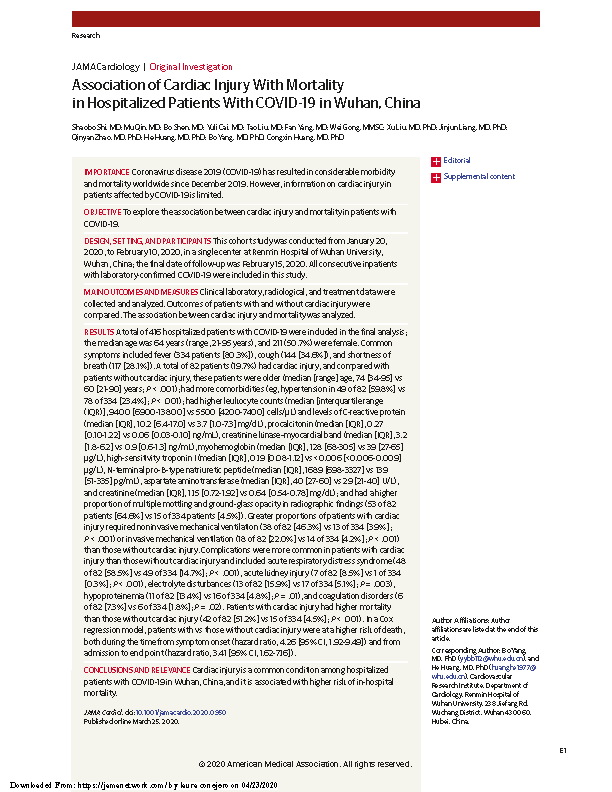Apr 23 Association of Cardiac Injury With Mortality in Hospitalized Patients With COVID-19 in Wuhan, China
Shaobo Shi, Mu Qin, Bo Shen, Yuli Cai, Tao Liu, Fan Yang, Wei Gong, Xu Liu, Jinjun Liang,
Qinyan Zhao, He Huang, Bo Yang, Congxin Huang,
ABSTRACT
Importance: Coronavirus disease 2019 (COVID-19) has resulted in considerable morbidity and mortality worldwide since December 2019. However, information on cardiac injuries in patients affected by COVID-19 is limited.
Objective: To study the association between cardiac injury and mortality in patients with COVID-19.
Design, setting and participants: This cohort study was conducted from January 20, 2020 to February 10, 2020 at a single center, Renmin Hospital of Wuhan University, Wuhan, China; the final follow-up date was February 15, 2020. All hospitalized patients with laboratory-confirmed COVID-19 were included in this study.
Main results and measures: Clinical laboratory, radiological and treatment data were collected and analyzed. The results of patients with and without cardiac injury were compared. The association between cardiac injury and mortality was analyzed.
A total of 416 hospitalized patients with COVID-19 were included in the final analysis;
- The median age was 64 years (range, 21-95 years) and 211 (50,7%) were women.
- The most common symptoms included fever (334 patients [80.3%]), cough (144 [34.6%]), and respiratory problems (117 [28,1%]).
A total of 82 patients (19,7%) had cardiac injury and were compared with patients without cardiac injury:
- These patients were older (median [range] age, 74 [34-95] vs 60 [21-90] years; P < 0,001) and had higher levels of:
- Comorbidity (eg, hypertension in 49 of 82 [59.8%] vs 78 of 334 [23,4%]; P < 0,001);
- Leukocyte count (median [interquartile range (IQR)], 9400 [6900-13] vs 800 [5500-4200] cells/μL)
- C-reactive protein (median [IQR], 10.2 [6.4-17.0] vs 3.7 [1.0-7.3] mg/dL), (median [IQR], 0.27 [0.10-1.22] vs 0.06 [0.03-0.10] ng/mL) ,
- Creatinine kinase – myocardial band (median [IQR], 3.2 [1.8-6.2] vs 0.9 [0.6-1.3] ng/mL)
- Myohemoglobin (median [IQR], 128 [68-305] vs 39 [27-65] μg/L),
- High-sensitivity troponin I (median [IQR], 0.19 [0.08-1.12] vs <0.006 [<0.006-0.009] μg/L)
- N-terminal pro-B B-type natriuretic peptide (median [IQR], 1689 [698-3327] vs 139 [51-335] pg/ml)
- Aspartate aminotransferase (median [IQR], 40 [27-60] vs 29 [21-40] U/L)
- Creatinine (median [IQR], 1.15 [0.72-1.92] vs 0.64 [0.54-0.78] mg/dL);
- Proportion of multiple mottling and ground-glass opacity in radiographic findings (53 of 82 patients [64,6%] vs. 15 of 334 patients [4,5%]).
- Higher proportions of patients with heart disease.
- The injury required noninvasive mechanical ventilation (38 of 82 [46.3%] vs 13 of 334 [3.9%]; P < .001) or invasive mechanical ventilation (18 of 82 [22.0%] vs 14 of 334 [4.2%]; P <.001) than those without cardiac injury.
- Complications were more common in patients with heart disease than those without heart injury, including:
- Acute respiratory distress syndrome (48 of 82 [58.5%] vs 49 of 334 [14.7%]; P <.001)
- Acute kidney injury (7 of 82 [8.5%] vs 1 of 334 [0,3%]; P <.001)
- Electrolyte alterations (13 of 82 [15.9%] vs 17 of 334 [5.1%]; P = .003),
- Hypoproteinemia (11 of 82 [13.4%] vs 16 of 334 [4.8%]; P = .01), and coagulation disorders (6 of 82 [7.3%] vs 6 of 334 [1.8%]; P = 0,02), XNUMX).
- Patients with cardiac injury had higher mortality than those without cardiac injury (42 of 82 [51.2%] vs 15 of 334 [4.5%]; P <.001).
- In a regression model, patients with cardiac lesions versus those without cardiac lesion had a higher risk of mortality, both from the onset of symptoms (hazard ratio, 4.26 [95% CI, 1.92-9.49]) and from admission to the hospital. end point (hazard ratio, 3.41 [95% CI, 1.62-7.16]).
Conclusions and relevance: Cardiac injury is a common condition among hospitalized COVID-19 patients in Wuhan, China, and is associated with an increased risk of hospitalization and mortality.



